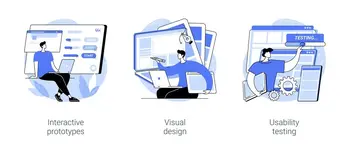
Table of contents
Interactive training in workshops and development programs are becoming more popular in the workplace. They help employees learn and remember new information. A
study
by LinkedIn found that companies that invest in these programs have 30-50% higher employee retention rates.
Interactive training programs are more engaging and personalized than traditional lectures. Employees can participate in activities that help them apply what they learn in real life. This makes learning more fun and allows employees to remember information better.
Interactive training programs can be tailored to each employee’s needs. If an employee is struggling with a skill, they can get extra help until they feel confident. This personalized approach shows employees that their employer cares about their growth and development.
The Basics of Interactive Training and Development Programs
1. What are Interactive Training Programs?
Interactive training programs are learning experiences where the trainee needs to do things, not just listen. These programs use different activities to keep learners interested and help them remember information better. Interactive training programs can be done in different ways, like in a classroom, online, by pretending to be in a real situation, or by playing games.
One of the most important things about interactive training programs is that they give learners feedback right away. This feedback helps learners see what they are good at and what they need to work on. Interactive training programs also let learners practice their skills in a safe place, which helps them feel more confident.
2. The Benefits of Interactive Training Programs

Interactive training programs are good for learners and companies. A study found that companies that use interactive training methods have a 25% to 60% higher rate of people remembering what they learned than companies that use traditional training methods. Here are some of the benefits of interactive training programs:
(a) Enhanced Learning Experience
Interactive training programs are more fun and easier to remember than traditional training methods. They use things like quizzes, games, simulations, and case studies to keep learners interested.
- Quizzes and Assessments: Quizzes in interactive training aren’t just about testing knowledge. They are also a way to learn. Quizzes are designed to challenge learners, help them remember key concepts, and give them instant feedback. This helps learners see how much they understand and where they need to study more. The competition element makes quizzes more fun and exciting.
- Immersive Simulations: Simulations are the heart of interactive training. They allow learners to experience real-world situations without real-world consequences. This way, learners can apply their knowledge to practical problems and practice making decisions without any risk. Simulations can be used to teach learners how to negotiate business deals, handle medical emergencies, or solve other problems.
- Engaging Games: Games can be more than just fun. They can also be powerful learning tools. Interactive training uses game design principles to turn learning modules into exciting quests. Learners progress through the content by mastering concepts, solving challenges, and working with others. This approach makes learning more motivating and rewarding.
- Real-world Case Studies: Interactive training brings case studies to life by making them interactive stories. Learners become active participants in analyzing complex problems and devising solutions. This dynamic approach encourages deeper thinking and exploration of different strategies. It also helps learners understand the material in a more holistic way.
By using interactive elements, training sessions become more engaging and memorable. Learners are more likely to pay attention, participate, and remember what they learn. This helps them become more active contributors and apply their knowledge in real-world situations.
(b) Improved Learning Outcomes

Interactive training programs help people remember information better because they make people actively participate in learning. When people talk about the material, do activities, and solve problems, they are more likely to understand it. This participation makes the brain work in different ways and helps people remember things better. Gamified quizzes and interactive simulations are also fun and help people remember key concepts by repeating them.
These training programs also give people feedback right away. This is important because it helps people know how well they are learning. Instead of waiting for a test or grade, people get feedback on their work right away. This feedback helps people see what they are doing well and what they need to work on. If someone is struggling with a concept, they can go back and review the material or get help from the teacher. This helps people learn in a way that works best for them and helps them remember the material better.
(c) Cost-Effective
Interactive training programs can be done on the Internet, which makes them cheaper than traditional training in classrooms. This online method does not need renting rooms, printing materials, or other costs for in-person workshops. Also, online platforms can be used by many people without extra costs, so organizations can use their resources well.
Interactive online training is not only cheaper but also faster. People can learn in their own time and place, so they do not need to travel or pay for it. This is especially good for organizations with people in different places because they do not need to make everyone come to the same place. Also, the programs can be divided into small parts, so people can learn at their own pace without having to stop their work. This saves money and time for the organization.
Using online interactive training also allows using digital tools that make learning more fun and easy to remember. Things like games, quizzes, simulations, and videos can be added to the training platform, making the learning experience more interesting.
Overall, interactive online training is a good choice for organizations because it is cheaper and faster than traditional training. It also makes learning more fun and easy to remember.
(d) Increased Employee Engagement

Interactive training programs help employees feel more interested and involved in their learning. This can lead to more happiness with their job and less people leaving the company. When employees take part in interactive workshops, they feel like they have control over their own learning. They can share ideas, solve problems together, and have important discussions. This makes them more connected to the material they are learning. This higher level of interest does not just stay in the training room. It goes with them to work, where they are more motivated to use their new knowledge and skills.
Also, the interactive nature of these training sessions creates a positive and fun learning environment. The energy and excitement from group activities, role-playing, and hands-on exercises spread beyond the workshop itself. Employees who actively participate with their colleagues and trainers build stronger relationships, which improves teamwork and communication. This means they are more likely to work well together on projects, share ideas, and come up with new ideas for the company. This collaborative spirit also helps create a more peaceful and supportive work environment.
Employee engagement is not just a short-term benefit of interactive training. It becomes an important part of a company’s culture in team building. Employees who feel valued, challenged, and involved in their learning are more likely to be loyal and committed to their employers. This loyalty leads to lower turnover rates, as employees are less likely to look for jobs elsewhere. The feeling of satisfaction from taking part in interactive learning journeys contributes to a positive overall view of their professional development at the company. In the end, by investing in interactive training, companies create a workforce that is not only well-equipped with skills but also highly engaged in their roles and committed to the long-term success of the company.
(e) Better Performance

Interactive training programs help employees learn new skills and knowledge by doing things and pretending to be in real-world situations. This is different from just listening to lectures or reading books. Interactive training helps employees understand their jobs better and feel more confident about doing them.
Interactive training also helps employees learn how to solve problems together. They work in groups to discuss different ways to solve problems and learn from each other. This helps them think more creatively and come up with better solutions.
After interactive training, employees are better at their jobs and more willing to help their teams. This leads to better performance and productivity for the company.
Interactive training is a way for companies to keep their employees learning and growing. This helps companies stay ahead of the competition and succeed in the long run.
(f) Customizable
Interactive training programs can be customized to meet the specific needs of an organization. They can be tailored to address specific skills gaps or to align with an organization’s culture and values.
Overall, interactive training programs provide a more engaging and effective learning experience than traditional training methods. They help learners retain information more effectively, improve performance, and increase employee engagement. Organizations that use interactive training methods can benefit from higher retention rates, improved performance, and reduced costs.
The Importance of Employee Development

Employee development is crucial for the growth of both the employee and the organization they work for. It is the process of enhancing an employee’s skills, knowledge, and abilities to improve their job performance and prepare them for future roles within the company.
i. Why Development is Crucial for Employee Growth
Investing in employee development can lead to numerous benefits for both the employee and the organization. According to a study by LinkedIn,
30-50% of employees
would stay at a company longer if it invested in their career development. Additionally, 34% of employees who receive poor job training leave their positions within the first year.
Employees who feel that their employer is invested in their growth are more engaged, productive, and loyal. They are also more likely to take on new challenges and responsibilities, which can lead to career advancement opportunities.
ii. How Interactive Training Programs Can Aid in Employee Development
Interactive training programs are an effective way to aid in employee development. These programs allow employees to actively participate in their learning, which can lead to increased engagement and retention of information.
Interactive training programs can also be tailored to an employee’s needs and learning style. For example, if an employee learns better through hands-on activities, an interactive training program that incorporates simulations and role-playing exercises would be more effective than a traditional lecture-style training program.
In addition, interactive training programs can provide instant feedback to employees, allowing them to identify areas where they need improvement and adjust their learning accordingly.
Overall, investing in employee development through interactive training programs is a win-win for both the employee and the organization. It leads to increased engagement, productivity, and job satisfaction for employees, while also improving the organization’s bottom line through reduced turnover rates and increased employee retention.
The Role of Technology in Interactive Training Programs

Interactive training programs have become an essential part of employee development in modern workplaces. Technology plays a crucial role in making these programs more effective and engaging. In this section, we will discuss the advantages of using technology in training programs and how to choose the right platform for your interactive training program.
The Advantages of Using Technology in Training Programs
Technology has revolutionized the way we learn and has made training programs more accessible, engaging, and effective. Here are some of the advantages of using technology in training programs:
1. Greater Engagement
Interactive training programs that use technology can keep learners interested and motivated. For example,
using games can make learning more fun
and challenging, which helps people remember things better. Adding things like leaderboards, badges, and rewards can make learning feel like a fun adventure. Learners earn points or achievements for completing tasks and learning new things, which helps them feel like they are competing with others. This not only makes them want to learn more, but it also encourages them to study harder to get rewards and show off their progress.
Interactive training platforms can also give real-time feedback, so learners can see how they are doing right away. For example, interactive quizzes after each section can help learners understand how well they know the material. This immediate feedback loop not only helps learners learn more effectively, but it also encourages them to keep learning. Learners can see where they need to improve and go back over those areas to learn more. This interactive feedback system gives learners control over their own learning and lets them learn at their own pace.
2. Personalized Learning
Technology can help make learning more personal for employees. For example, learning management systems (LMS) can keep track of how much each person has learned and give them specific feedback and suggestions.
An LMS is a computer program that stores and delivers training materials. It can also track learners’ progress and provide them with reports on their performance. This information can be used to create personalized learning plans for each employee.
For example, if an employee is struggling with a particular topic, the LMS can recommend additional resources or activities. Or, if an employee is already familiar with a topic, the LMS can provide them with a more challenging assignment.
Personalized learning can help employees learn more effectively and efficiently. It can also help them stay motivated and engaged in their training.
3. Cost-Effective

Technology can make training programs cheaper by getting rid of the need for in-person classes and paper through the use of virtual training and virtual workshops. This can save companies a lot of money in the long run. By using online training platforms, businesses can avoid the costs of renting rooms, travelling, staying in hotels, and buying food, which are often needed for traditional workshop activities. With interactive online training, people can join the classes from their own homes, so there is no need for physical buildings or transportation.
Also, switching from paper training materials to digital resources can save money. Digital content can be easily updated and shared without the costs of printing, shipping, and handling. This not only helps the environment but also makes sure that people have the most recent information. Also, being able to track people’s progress and involvement digitally makes it easier to grade and report, which simplifies administrative tasks and frees up resources for more important things. So, technology-based interactive training is a cost-effective solution that gives the best learning results while also minimizing financial stress for companies of all sizes.
4. Flexibility

Technology can help learners learn at their own time and place. This is helpful for people who work from home or have busy schedules. With online learning platforms, people can learn when they want, not just when the workshop is scheduled. They can learn during their lunch break, on the bus, or even after work.
They can also learn on any device, like a laptop, tablet, or phone. This means they don’t have to go to a specific place to learn. They can learn anywhere they have an internet connection.
This flexibility saves time and money. People don’t have to travel to a workshop, so they save on gas and parking. They also don’t have to take time off work, so they save on lost wages.
People who work from home can also participate in interactive sessions, even if they are in different time zones. This is because the sessions are online and can be accessed at any time.
People can also revisit and review the materials as often as they need to. This helps them learn the material at their own pace and understand it better.
This new flexibility is a great way to learn. It is more convenient and saves time and money. It also makes it possible for people to learn from anywhere in the world.
5. Improved Retention
Training programs that use technology can help people remember things better because they are more interesting and engaging. For example, virtual reality (VR) simulations let people practice skills in a safe and controlled way. This helps them learn the skills better and remember them longer.
VR simulations are more interesting than traditional workshops because they let people be active participants. In VR simulations, people make decisions and face consequences. This makes the learning experience more emotional, which helps people remember things better.
VR training is more likely to help people remember things because it is more interesting and engaging. This leads to a workforce that is more knowledgeable and skilled.
Choosing the Right Platform for Your Interactive Training Program

Choosing the right platform for your interactive training program is essential for its success. Here are some factors to consider when selecting a platform:
Ease of Use: The platform should be easy to use and navigate for both learners and trainers.
Compatibility: The platform should be compatible with different devices and operating systems to ensure maximum accessibility.
Engagement Features: The platform should have engagement features such as gamification, social learning, and interactive assessments to keep learners engaged and motivated.
Analytics and Reporting: The platform should provide analytics and reporting features to track learners’ progress and identify areas that need improvement.
Security: The platform should have robust security features to protect sensitive data and prevent unauthorized access.
According to a study by eLearning Industry,
72% of companies
say that e-learning helps them keep up-to-date with changes in their industry, and 56% of employees feel that e-learning helps them achieve their career goals. These statistics highlight the importance of using technology in training programs and choosing the right platform for your interactive training program.
In conclusion, technology plays a crucial role in making interactive training programs more effective and engaging. By considering the advantages of using technology in training programs and choosing the right platform, companies can create personalized, cost-effective, and flexible training programs that improve retention rates and employee performance.
Maximizing Production with Interactive Training Programs

Interactive training programs are becoming increasingly popular in the workplace due to their effectiveness in improving employee performance and productivity. In this section, we will explore how interactive training programs can improve production and the benefits of LMS in interactive training programs.
How Interactive Training Programs Can Improve Production
Interactive training programs are designed to engage learners through hands-on activities, simulations, and games. This type of training is more effective than traditional classroom-style training because it allows learners to apply what they have learned in a real-world context.
According to a
study
, companies that offer comprehensive training programs have 218% higher income per employee than those with less comprehensive training. This statistic shows that investing in interactive training programs can lead to a significant increase in production and revenue.
Interactive training programs can also improve production by reducing errors and increasing efficiency. For example, a manufacturing company can use interactive training programs to teach employees how to operate machinery safely and efficiently, reducing the risk of accidents and increasing production output.
The Benefits of LMS in Interactive Training Programs
Learning Management Systems (LMS) are software applications that allow companies to manage and deliver training content to their employees. LMS can be used to deliver interactive training programs, making it easier for companies to track employee progress and evaluate the effectiveness of their training programs.
LMS can also save companies time and money by reducing the need for traditional classroom-style training. In addition, LMS can provide employees with access to training content anytime, anywhere, making it easier for them to complete training modules at their own pace. This flexibility can improve employee engagement and retention, leading to a more productive workforce.
In conclusion, interactive training programs can improve production by engaging learners and allowing them to apply what they have learned in a real-world context. LMS can enhance the effectiveness of interactive training programs by providing companies with tools to manage and deliver training content to their employees. By investing in interactive training programs and LMS, companies can improve employee performance and productivity, leading to increased revenue and success.
The Future of Interactive Training Programs

As technology continues to advance, it’s no surprise that interactive training programs will continue to evolve as well. With the increasing popularity of virtual reality (VR) and augmented reality (AR), the future of interactive training programs is looking bright.
i. What to Expect from the Future of Interactive Training Programs
In the future, interactive training programs will become even more immersive and engaging. With the use of VR and AR, trainees will be able to experience real-life scenarios in a safe and controlled environment. This will allow them to practice and perfect their skills without the risk of real-world consequences.
Another trend that we can expect to see in the future of interactive training programs is the use of artificial intelligence (AI). AI can help personalize the training experience for each individual trainee, making it more effective and efficient. It can also provide instant feedback and analysis, allowing trainees to improve their skills faster.
ii. The Potential of Interactive Training Devices
One of the most exciting developments in the future of interactive training programs is the potential of interactive training devices. These devices can range from wearables that track a trainee’s movements to haptic feedback devices that simulate touch and pressure.
For example, a firefighter training program could use a haptic feedback device to simulate the weight and resistance of a hose, allowing trainees to practice their technique and build muscle memory. Similarly, a surgeon training program could use a haptic feedback device to simulate the resistance and texture of different organs, allowing trainees to practice their surgical skills in a realistic and safe environment.
In conclusion, the future of interactive training programs is looking bright. With the use of VR, AR, AI, and interactive training devices, trainees will be able to experience realistic scenarios and receive personalized feedback like never before. As technology continues to advance, the possibilities for interactive training programs are endless.







